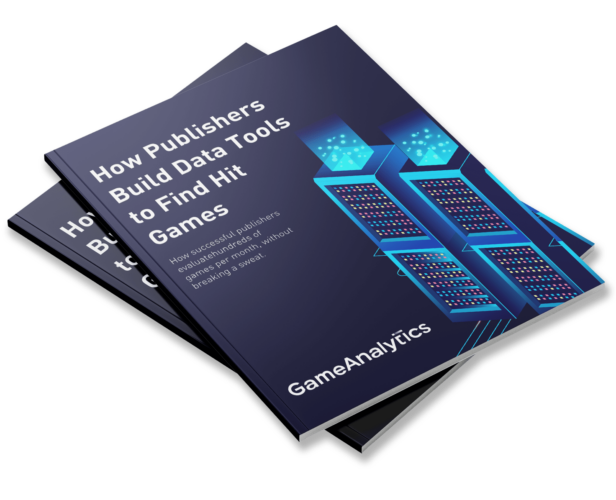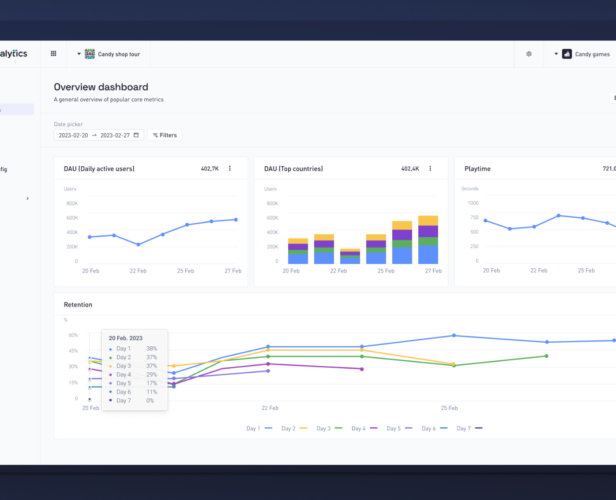Resources > All
Insights and tips about the games industry
Subscribe for gaming insights, industry reports and product updates delivered straight to your inbox.
#Commentary
Navigating the World of Matchmaking: Tips for Game Developers
When building a multiplayer game, your players are going to need a way to find each other. That's where a matchmaker comes in. But what is a matchmaker? How do they work? And is there any difference when it comes to mobile?
#Commentary
9 Areas You Should Focus Your Mobile Game Development in 2024
What exactly should you be focusing on this year? What are the trends that will really impact your development? We’ve dug through the most popular trends and brought together the topics you should keep an eye on in 2024. 1. Learn about AI and Machine Learning With the release of Google’s Gemini, we’re seeing AI continue to explode. It won’t be long before it’s a common tool that we all use day to day. Getting to grips with how it works is going to be essential, particularly in gaming. At the same time, we’re seeing hyper-casual games shift to richer and deeper experiences – becoming hybrid-casual. In fact, the number of hyper-casual games dropped by 18%, while hybrid-casual grew by 13%, according to Sensor Tower. By their nature, hybrid-casual games have a longer development cycle than hyper-casual games. Using AI...
#Commentary
Game industry trends to expect in 2024
As we enter the new year, the anticipation is high for the unfolding trends that are about to redefine how we create and play games—from AI seamlessly crafting entire game worlds to the ongoing rise of mobile gaming popularity, where developers refine strategies to extend engagement and enhance monetization, alongside their focus on diversity and sustainability. AI keeps revolutionizing development dynamics Traditionally, creating expansive open-world games with stunning graphics required large teams and significant time investments. But lately, AI is becoming a leader in a new era where even smaller studios and indie developers gain access to tools enabling the next generation of artwork. That includes the creation of entire worlds through procedural techniques, dynamic dialogue generation, or even players’ live avatar integration within the game. These AI technologies are currently in their early stages, but the trajectory is clear...
#Product updates
Decoding players’ patterns with engagement tracing
Addressing developers’ demands for more nuanced retention analysis, we created a solution beyond conventional retention metrics, empowering developers and studios to gain a deeper understanding of player behavior and refine their strategies for long-term success. Our engagement feature enables developers to filter retention based on various event types, offering a granular view of player behavior beyond standard global filters such as country or platform. By creating custom cohorts for retention, developers can tailor their analyses to specific in-game actions, answering critical questions such as whether users return after completing a particular level, making specific purchases, or investing resources in the game. Here is everything you need to know about this feature: Tracking event-based player retention While traditional retention metrics usually focus on install-based data, GameAnalytics’s Engagement feature allows you to filter retention based on player events. You can explore player...
#Commentary
Cybersecurity for Game Developers: Top Tips to Stay Safe
Protecting yourself isn’t necessarily hard. Not if you’re aware of the techniques hackers use. So, with data breaches becoming increasingly common in the news, we thought we’d give a little advice about how to protect yourself.
#Commentary
AI-Driven Creativity: Prototyping Games in the Digital Age
While you can’t (yet) plug in a prompt and have it develop a fully functional mobile game, you can use AI to help you come up with ideas and speed up your process. So here are a few ways you can use AI when developing your prototypes.
#Commentary
From console to pocket: How to adapt your game for mobile
Adapting your game to mobile is no walk in the park. Yoru controls are different, you have a much smaller screen size, and you're much more limited with the hardware. And yet, Psyonix nailed this perfectly. Here’s what we can learn from them.
#Product updates
GameAnalytics’ Journey to Analytics Excellence – H2 2023 Updates and Improvements
In the dynamic world of GameAnalytics development, evolution is the constant. While our recent endeavors have been focused on launching GameAnalytics Pro, our commitment to refining and enhancing our standard offerings for everyone never wavered. We are convinced that empowering game development starts by cultivating a sophisticated, cost-efficient, and powerful analytics ecosystem for developers and studios of all shapes, sizes, and budgets. Apart from the launch of GameAnalytics Pro, we’ve delved deep into refining key features, ensuring our platform meets and exceeds your expectations. From comprehensive portfolio overviews to advanced filtering controls and character limit expansions, each improvement has been meticulously designed to empower your decision-making and analysis, offering you a richer, more streamlined analytics toolkit to fuel your game development success. Let us walk you through these impactful releases available for everyone: Portfolio overview This new feature helps developers...
#Guest posts
Retention Rate Secrets to Reduce User Churn
Out of all the many mobile industry benchmarks, it’s important to keep player retention rates top of mind. Retention allows marketers to understand when, and perhaps why, a user leaves their game — which gives you the ability to slow the rate down and keep your users around. In this article, we’ll cover the basics of mobile game retention rates and some of the secrets game marketing pros deploy to reduce churn, as well as look at how you can learn from your retention metrics. What’s The Point of Retention Rate? Retention rates are a key indicator of game growth and its health. Not only does a game with better retention likely mean players enjoy using it, but good retention also means it can generate revenue quickly. In the meantime, low retention means rapid user churn, lower user reviews, and...
#Product updates
Introducing GameAnalytics Pro – Your Gateway to Deeper Insights
We’re excited to share news about a new initiative we’re rolling out – GameAnalytics Pro. This step towards a paid offering comes from a place of necessity and aspiration. Our aim has always been to provide reliable, insightful tools to help your studio thrive. And to continue improving and expanding our offerings, we are introducing this new premium tier. With GameAnalytics Pro, we intend to augment our service via new tools tailored to meet the evolving needs of your studio. The new premium offer is completely optional. We remain fully committed to our free offering, ensuring every studio, big or small, continues to have access to solid analytics tools at no cost. GameAnalytics Pro is an extra option for those wanting to dive deeper into their data. Why are we launching Pro? The introduction of Pro is a significant move...
#Case study
Insights in Action: VRMonkey’s Rise Fueled by GameAnalytics
VRMonkey, formerly known as Naked Monkey Games, embarked on a journey into VR a decade ago. Although their activities initially evolved around developing smartphone games, in 2015, after encountering Oculus Rift DK1, they decided to pivot fully into VR and AR development. Today, this indie studio comprises 40 dedicated team members who work on their own IPs and collaborate with renowned VR studios worldwide, including The Munky – creators of Drunkn Bar Fight. Among VRMonkey’s portfolio, their co-development of Drunkn Bar Fight stands out as one of their most successful ventures. This game is among the top 20 selling VR Games of all time, and it maintains a steady audience, with more than 100,000 MAU. During peak seasons and featured store placements, this number rises to 200,000 MAU. Harnessing the Power of Analytics VRMonkey recognized that they must fuel their...
#Guides
Influencer Partnerships: The Key to Expanding Your Game’s Reach
Working with social media influencers can open up an ocean of new players for your games. But who are the best influencers to work with? How do you go about finding them? And how can you get in touch with them?
#Commentary
The Cost of Entertainment: Are Games Getting Too Expensive?
A big topic we see today is people complaining about the price of games for what they’re getting. But why is that? Are studios becoming too greedy? Or are business models evolving so quickly that players can’t keep up with the trends? Let's find out.
#Editor's pick
The Game Developer’s Handbook to Mastering Data Solutions
Data is the key to success in the ever-evolving landscape of game development. Explore this guide to transform your data into insights using our turn-key data solutions. What’s inside? Our comprehensive guide explores cost-saving strategies and real-world applications for advanced use cases. Learn how to seamlessly integrate data sources, unlock detailed player insights with Player Warehouse, access real-time data with Raw Export, and ensure data privacy compliance.
#Case study
Developing a #1 VR MMO: Ramen VR’s Journey with GameAnalytics
Discover how Ramen VR used data-driven game development to launch "Zenith: The Last City", which became the #1 bestselling game all major VR platforms—including Meta Quest/Rift, Steam and PlayStation VR.
#Editor's pick
Using AI to Supercharge Your Game Art Design
Discover how tweaking AI tool settings can help you generate varied art styles, produce better concepts, and speed up the process from prototype to final design. With AI on your team, creating unique game art has never been easier or faster.
#Editor's pick
Event Design & Tracking Guide for GameAnalytics
Learn how to create an adaptable tracking plan, enabling you to unlock richer insights and maximize the value of your data within GameAnalytics.
#Editor's pick
From Zero to Hero: Tracking Key Success Pillars in Gaming
Our COO, Allison, recently joined Mobvista for the first episode of their "From Zero to Hero" video series. Watch the video today for a detailed overview into tracking three essential pillars of gaming success: Acquisition, Engagement, and Monetization.
#Editor's pick
How studios use DataSuite to find hit games
Learn how successful publishers evaluate hundreds of games per month, to find the next hit game.
#Editor's pick
Among Us VR dev talks about how to create immersive worlds
VR is all about immersion. It’s about allowing players to lose themselves in more than just a game, but a new world. You have to build VR experiences the right way to make this happen. This goal is always top-of-mind for Schell Games. In this interview, we spoke to Schell Games’ Vice President of Product, Charlie Amis, to learn their story. “For VR, you want to make the player feel like they’re actually in the world you’ve created. This isn’t as true or a high priority in PC and console games. If people start to lose that sense of presence and immersion, then a lot of the reason they put the headset on is hurt. They want to go to another world or be someone new. So you need to help them feel like they’re really there and really that...
#Editor's pick
GameAnalytics H1 Update: New Product Improvements!
It’s been a busy time since February, when the largest update in GameAnalytics history was launched. Read on for more information about what’s changed recently, and new functionality coming to the platform very soon.
#Case study
How TapNation uses DataSuite to increase the LTV of 19 hit games by 50% in only 6 months
Smashing obstacles with Giant Rush While they’ve seen huge improvements using DataSuite across their portfolio, one game stands out in particular: Giant Rush. (And not just because the character is huge.) The title has now reached over 140 million downloads. And, through a series of A/B tests and insights from the data they collected, they’ve been able to increase the LTV by a whopping 200% over six months for this specific title. “It’s because we A/B test every day,” Philippe Grazina from TapNation says. “We ask questions like: When are players leaving the game? For example, the boss in Giant Rush. If we spot that they’re leaving at the same point every time, we know we need to make a change. Small details like that really help.” Through these granular insights, TapNation can iterate and improve on their game step...
#Editor's pick
How to Build a Data Warehouse for Games from Scratch
Over our last couple of blogs around data warehouses, we’ve explained how they let you analyze data from across your portfolio and look at what insights you can gather from them. Now, we’ll dive into how to build a data warehouse. What steps do you need to take and what resources will you need? To figure this out, we’ve rounded up the costs, steps, and tools we think you’ll need to get started. Please note, that we haven’t included the cost of running an engineering department (which you’ll need), which can end up being a lot of $$$. What do I need to get started? Before you start, you’ll need to ensure you have the right people. You’ll likely need a software or data engineer, and perhaps an architect or DevOps engineer. You’ll also need to budget for tools like...

























